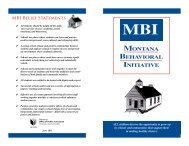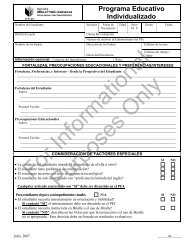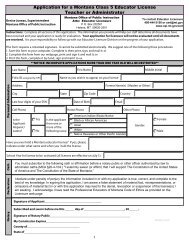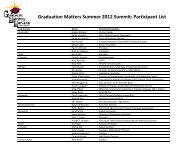OT/PT Guidelines - Montana Office of Public Instruction
OT/PT Guidelines - Montana Office of Public Instruction
OT/PT Guidelines - Montana Office of Public Instruction
Create successful ePaper yourself
Turn your PDF publications into a flip-book with our unique Google optimized e-Paper software.
5. the expertise and service <strong>of</strong> an <strong>OT</strong> and/or <strong>PT</strong> is required to meet the student’s identified<br />
needs or to assist the team in providing or developing the special educational program.<br />
Therapists use a combination <strong>of</strong> standardized assessments, functional assessments and classroom<br />
observations to determine needs. However, determination <strong>of</strong> eligibility for entrance into<br />
occupational therapy and/or physical therapy service should be primarily based upon a student’s<br />
functional needs required to benefit from their special education program. The “Eligibility<br />
Criteria Form” (Appendix A) may be a useful tool for the IEP team to justify a student’s need for<br />
occupational therapy and/or physical therapy as a related service. Whether a student needs<br />
occupational therapy or physical therapy as a related service is an IEP team decision.<br />
Transfer Students. If a student comes from another district with <strong>OT</strong> and/or <strong>PT</strong> on his IEP, the<br />
therapist needs to be notified and involved immediately in serving the child and assessing his<br />
current needs.<br />
Progress Monitoring. Progress monitoring is an assessment practice that is used to assess<br />
student's academic or functional performance to evaluate the effectiveness <strong>of</strong> intervention<br />
strategies. To implement progress monitoring, the student’s current levels <strong>of</strong> functional<br />
performance are determined and goals are identified for learning that will take place over time.<br />
The student’s performance is measured on a regular basis. Progress toward meeting the student’s<br />
goals is measured by comparing expected and actual rates <strong>of</strong> achievement. Based on these<br />
measurements, interventions are adjusted as needed.<br />
Reevaluation. Reevaluations can occur for various reasons and must be conducted consistent<br />
with the requirements under IDEA.<br />
Purposes for a reevaluation:<br />
1. To determine additional accommodations needed<br />
2. To identify new goals<br />
3. To provide new baseline information<br />
4. To determine effectiveness <strong>of</strong> intervention and success <strong>of</strong> outcomes<br />
5. To identify changes in functional capabilities and limitations<br />
6. To determine the need for changes in service delivery or need for services<br />
7. To help in planning interventions<br />
8. For ongoing progress monitoring<br />
9. To determine access and progress in the general curriculum<br />
10. To determine present level <strong>of</strong> academic achievement and functional performance<br />
Exit Criteria. The IEP team should begin a discussion <strong>of</strong> exiting services when initial eligibility<br />
is determined. Exit criteria are tailored to student need. Exit criteria assist IEP team members in<br />
making decisions regarding the termination <strong>of</strong> occupational therapy or physical therapy services.<br />
One or more <strong>of</strong> the following criteria should be met before discussion to exit the student from<br />
related services.<br />
16











